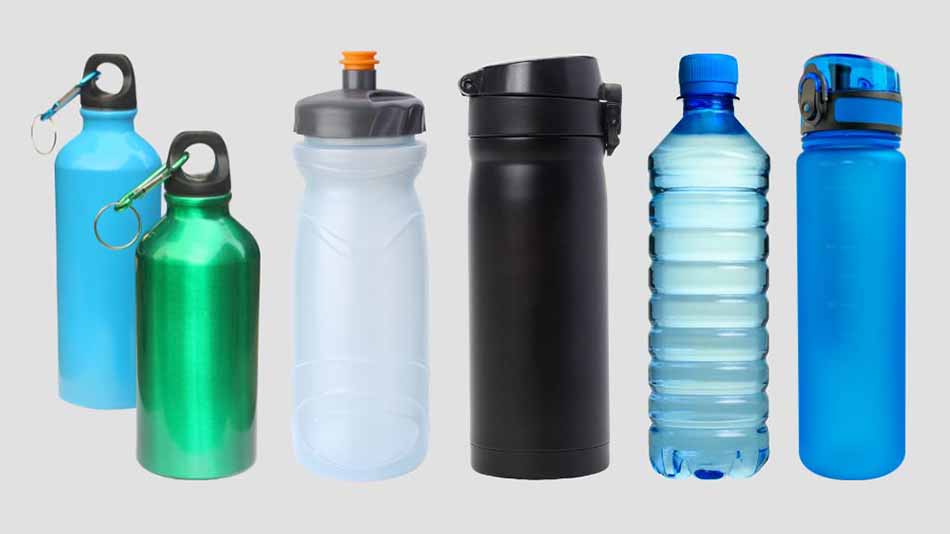Finding a safe, durable, affordable water bottle can be difficult. There are concerns like toxins leaching into the water, health and environmental impacts of the material, and so on.
Don’t worry much, though. We’re here to make your path easier with a detailed discussion on ‘which material water bottle is best for health?’. We will talk about common water bottle materials and explain whether they are healthy or not.
Ready to explore the best material for a water bottle?
Different Materials and Their Safety Levels
Here’s a quick sum-up of different materials and their safety measurements. Let’s have a glance at the table before digging deeper into the topic.
| Materials | Safety Measurement |
| Stainless Steel | Safest |
| Glass | Safest |
| Copper | Okay but there are some concerns |
| Silicone | Safe |
| Titanium | Safe |
| Plastic | Okay but there are some concerns |
| Aluminum | Okay but there are some concerns |
Which Material Water Bottle Is Best For Health?
This time, we will get into more detailed information regarding the materials of water bottles and how they impact your health.
Stainless Steel
Stainless steel water bottles are crafted from high-quality materials that are free from harmful chemicals. They are widely regarded as one of the non-toxic and safest options for everyday use.
Unlike plastic bottles, stainless steel does not leach chemicals into your water, even if it is scratched or exposed to high temperatures. This makes them a reliable choice for anyone concerned about the potential health risks of other materials.
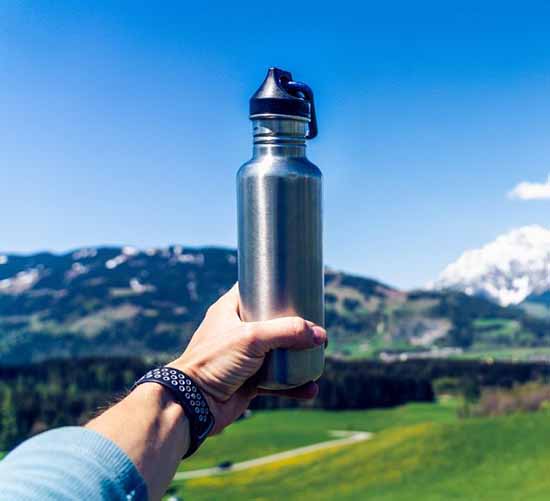
Key features of stainless steel water bottles:
- Made from culinary-grade stainless steel
- Available in various sizes and colors
- Insulated options to keep liquids hot or cold
- Lead-free and BPA-free
- Durable and long-lasting
Benefits of stainless steel water bottles:
- Non-toxic Material: Stainless steel is free from BPA and other harmful chemicals, ensuring your water remains pure and safe.
- Durability: These bottles are extremely durable and can withstand drops and bumps without breaking.
- Insulation: Many stainless steel bottles are insulated, keeping your drinks hot or cold for up to 24 hours.
- Easy to Clean: Stainless steel bottles can be easily cleaned with soap and water, reducing the risk of bacterial buildup.
- Taste: Stainless steel does not retain flavors, so your water tastes fresh every time.
Drawbacks of stainless steel water bottles
- Weight: Stainless steel bottles can be heavier than plastic alternatives, making them less convenient for some people.
- Dents: They can develop dents if dropped frequently.
- Cost: They are often more expensive than plastic bottles.
Recommended: Slim Stainless Steel Water Bottle
Glass
Glass water bottles offer a clean and pure drinking experience. According to CNN, experts suggest that using glass or stainless steel containers is a healthier option for drinking water. These materials do not leach harmful chemicals into the water, so yes, glass is safe to drink from.
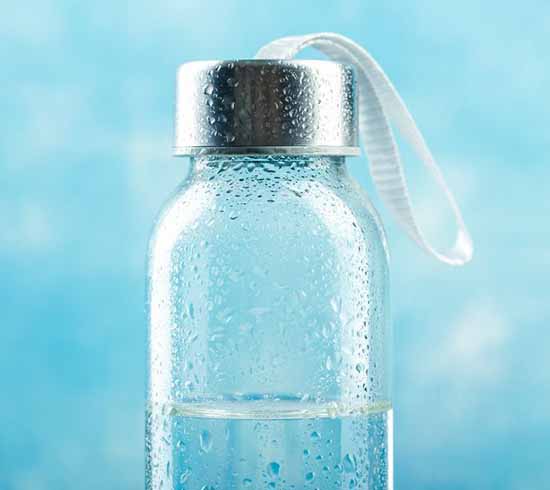
Key features of glass water bottles
- No BPA or harmful chemicals
- No impact on the water flavor
- Resistant to thermal shock
- Easy to monitor the water level
- Dishwasher-safe
Benefits of glass water bottles
- Health-Safe: No risk of chemical leaching, ensuring safe drinking water.
- No Taste Impact: Glass bottles do not retain or impart flavors, keeping your water pure.
- Easy Cleaning: Can be cleaned in the dishwasher without any special care.
- Visual Appeal: Transparent, making it easy to see how much water is left.
- Temperature Resistant: High-quality borosilicate glass can handle hot and cold liquids without shattering.
Drawbacks of glass water bottles
- Fragility: Glass can break if dropped, even with protective sleeves.
- Weight: Heavier than plastic or stainless steel bottles, making it less convenient for carrying around.
- Lack of Insulation: Glass bottles do not keep drinks cold or hot for long periods.
Copper
Copper water bottles are made from high-quality copper and are known for their antibacterial properties. When water is stored in a copper bottle, small amounts of copper ions dissolve into the water, which can be beneficial in moderation. However, excessive copper intake can be harmful, so proper usage is crucial.
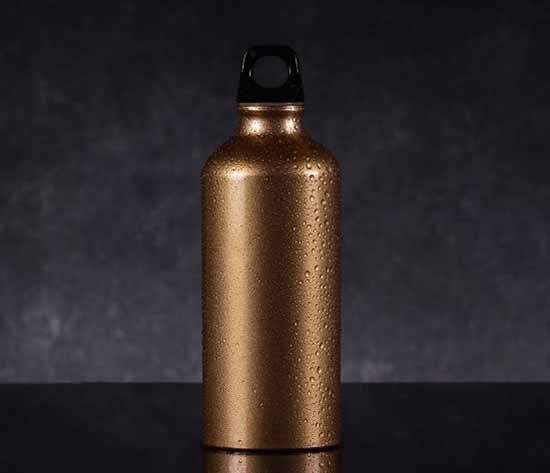
Features of copper water bottles
- Kills bacteria and microbes
- More eco-friendly than plastic
- Boosts immunity
Benefits of copper water bottles
- Antibacterial Properties: Copper can kill harmful bacteria and viruses in water, making it safer to drink.
- Health Benefits: Drinking water from copper bottles may boost the immune system and act as an antioxidant.
- Reduces Cholesterol: Copper can help lower triglyceride and cholesterol levels.
- Sustainability: Copper is a sustainable material, making it a better choice for the environment compared to plastic.
Drawbacks of copper water bottles
- Copper Poisoning: Overexposure to copper can lead to symptoms like nausea, abdominal pain, and liver damage.
- Digestive Issues: Some people may experience digestive issues and stomach cramps.
- Allergic Reactions: Those allergic to copper might experience rashes and irritation.
Silicone
Silicone water bottles have become popular for their flexibility, lightweight nature, and durability. These bottles are made from silica, found in sand, which is also the primary component of glass.
They are BPA-free, non-toxic, and can withstand extreme temperatures without degrading. These bottles are collapsible which makes them convenient for travel and outdoor activities.
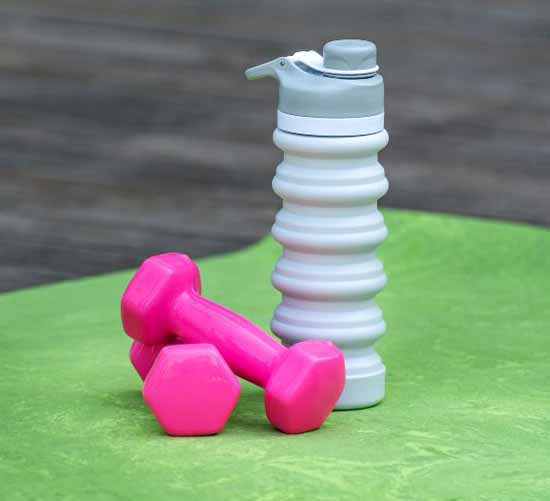
Features of silicone water bottles
- No harmful chemicals
- Easy to carry and store
- Can handle hot and cold beverages
Benefits of silicone water bottles
- Non-Toxic: Made from food-grade silicone, which does not leach harmful chemicals into beverages.
- Durable: Resistant to cracking, breaking, and temperature fluctuations.
- Eco-Friendly: Long-lasting and helps reduce plastic waste.
- Convenient: Collapsible and lightweight, perfect for on-the-go use.
- Easy to Clean: Dishwasher-safe, making them easy to maintain.
Drawbacks of silicone water bottles
- Limited Research: While considered safe, there is less research on the long-term health effects of using silicone water bottles compared to more traditional materials like glass or stainless steel.
- Synthetic Material: Despite being non-toxic, silicone is a synthetic material, and some people may prefer more natural options.
Titanium
Titanium is a highly durable and lightweight metal that does not corrode. It is also biocompatible, meaning it does not react adversely with the human body. These properties make titanium an excellent choice for water bottles, especially for those who need a sturdy and reliable option.
Studies have shown that titanium water bottles coated with titanium dioxide (TiO2) are effective in disinfecting water and safe to drink.
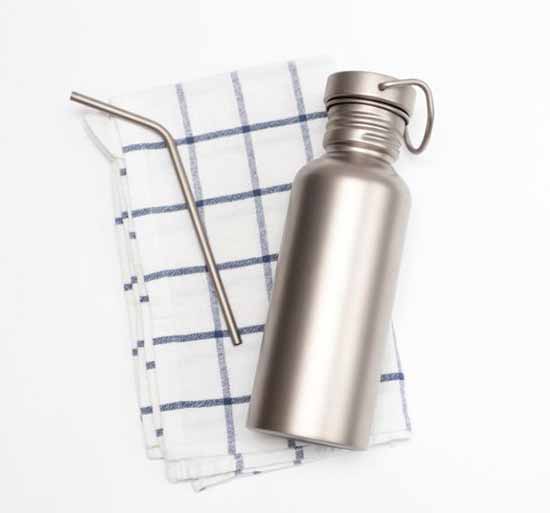
Features of Titanium water bottles
- Ultra lightweight
- Corrosion-Resistant
- Biocompatible
- High strength-to-density ratio
Benefits of Titanium water bottles
- Non-Toxic: Titanium does not leach harmful chemicals into the water.
- High Durability: Resistant to impacts and can last a lifetime with proper care.
- Lightweight: Easier to carry compared to stainless steel, ideal for outdoor activities.
- Corrosion-Resistant: Safe for both hot and cold beverages without risk of corrosion.
- No Taste Impact: Does not impart any metallic taste to the water.
- Hypoallergenic: Unlikely to cause allergic reactions.
- Biocompatible: Safe for long-term use with no health risks associated with the material.
Drawbacks of Titanium water bottles
- Cost: Significantly more expensive than other materials like plastic or stainless steel.
- Lack of Insulation: Most titanium bottles are not dual-wall vacuum insulated, which means they do not keep beverages hot or cold for extended periods.
Plastic
Plastic water bottles are widely used because they are inexpensive and convenient. However, they can pose health risks due to chemicals like Bisphenol A (BPA) that can leach into the water. The chance of chemical leaching is higher when the plastic is exposed to heat.
Researchers have discovered that bottled water contains a significant number of plastic particles. Using advanced imaging techniques, they found that an average liter of bottled water has about 240,000 plastic fragments, most of which are nanoplastics.
These tiny particles, which are less than 1 micrometer in size, can penetrate the body’s cells and tissues.
The study shows that bottled water contains many plastic particles, which could pose health risks. However, scientists are not yet sure how these tiny plastic pieces affect human health.
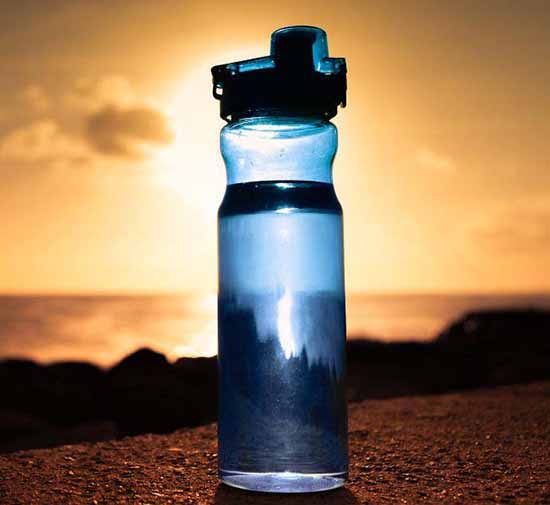
Features of Plastic water bottles
- Low cost
- Lightweight
- Versatile
Benefits of Plastic water bottles
- Widely Available: Easily found in stores and online, with numerous brands and styles to choose from.
- Durable: Resistant to impacts, which makes them less likely to break when dropped compared to glass.
- Versatile: Available in many shapes, colors, and textures. You can find rigid bottles with screw-top lids or flexible ones for easy drinking.
- Lightweight: Handy for carrying around, with collapsible options that fit easily into backpacks.
- Affordable: Generally inexpensive compared to other materials.
Drawbacks of Plastic water bottles
- Health Safety Concerns: BPA in hard plastic bottles can leach into drinks, mimicking estrogen and causing health issues like hormone disruption, cardiovascular diseases, and cancers.
- Environmental Impact: They contribute significantly to pollution and take a long time to decompose, often ending up in landfills or oceans.
- Durability: Prone to cracking, warping, and scratching over time, which can increase the risk of chemical leaching.
- Odor Retention: Can develop unpleasant smells from absorbed food and drink scents.
- Not Dishwasher Safe: Heat can increase the risk of chemical leaching, so you should hand-wash plastic bottles.
- Short Lifespan: Compared to metal or glass, plastic bottles age quickly and may need to be replaced more often.
Please note that BPA-free plastic bottles labeled with numbers 2, 4, and 5 are safe for drinking water.
These include high-density polyethylene (HDPE), low-density polyethylene (LDPE), and polypropylene. They do not leach harmful chemicals into the water. Avoid plastics labeled with numbers 3, 6, and 7, as they may contain harmful substances like BPA. Always check labels and choose BPA-free options for safer drinking.
Recommended: Insulated Plastic Water Bottle
Aluminum
Aluminum water bottles are light and cheaper than stainless steel ones. The problem is that they need an inner lining to stop the aluminum from reacting with acidic drinks. This lining can be risky if it contains harmful chemicals like BPA.
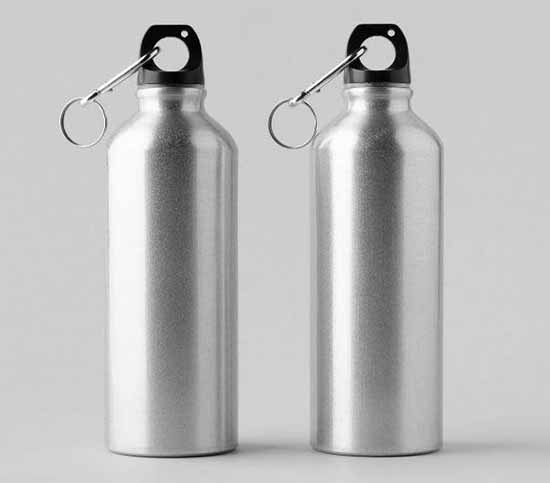
Features of Aluminum water bottles
- Affordable
- Lined Interior
- Lightweight
Benefits of Aluminum water bottles
- Lightweight: Aluminum bottles are very light, making them convenient for travel and outdoor activities.
- Affordable: Typically cheaper than stainless steel bottles, offering a budget-friendly option.
- Thermal Efficiency: Can keep beverages hot or cold for several hours.
- Stylish: Available in various colors and designs, making them visually appealing.
- Recyclable: Aluminum is a material that can be recycled. This feature makes it a more environmentally friendly option compared to plastic.
Drawbacks of Aluminum water bottles
- Health Risks: The interior lining may contain BPA or other harmful chemicals, which can leach into beverages.
- Flavor Retention: Flavors from previous drinks can cling to the lining. It eventually affects the taste of subsequent beverages.
- Not Dishwasher Safe: These bottles require handwashing to avoid damaging the lining.
Recommended: Lightweight Aluminum Water Bottle
Which Material Should You Choose?
Hopefully, you have a crystal clear idea about common water bottle materials and their impact on your health.
Still, if you ask for our recommendation, stainless steel water bottles are highly recommended for health and safety. They are free from harmful chemicals, such as BPA, and do not leach any substances into your water, even when scratched or exposed to high temperatures.
They are durable, easy to clean, and come insulated to keep your beverages at the desired temperature. Stainless steel offers a reliable and safe option for daily hydration needs.
FAQs
Which Material Is Good for Storing Drinking Water?
Glass and stainless steel are the best materials for storing drinking water. Glass keeps the water pure and unaffected by container flavors, ensuring a clean taste. It also offers peace of mind as it is chemical-free. Both materials are safe and easy to clean which makes them excellent choices for storing water.
How Long Can You Keep Bottled Water?
Unopened bottled water is safe to drink indefinitely, but it’s best to consume it within 2 years for optimal quality. Once opened, drink it within a few days to avoid contamination. Store it in a cool, dark place. Always check for changes in taste, smell, or appearance before drinking. If unsure, replace the water to ensure safety.
Last Thoughts
Hopefully, you’ve got a clear answer to the question- which material water bottle is best for health?
Every material offers individual pros and cons. Some are considered completely safe, but some materials have some concerns. However, stainless steel and glass are the best materials for water bottles due to their safety and durability. You can go for plastic water bottles as well, just make sure the material is BPA-free and non-toxic.
Good luck, and stay hydrated!

